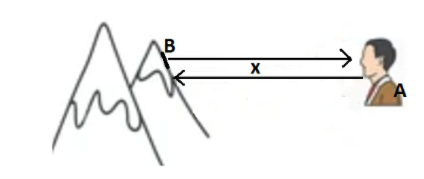
If d is the distance between the source of sound and reflector \[{{\text{t}}_{\text{1}}}\] , \[{{\text{t}}_{\text{2}}}\] are times at which echoes are heard, the expression for determination of velocity of sound in air by echo method is:
(A) \[\dfrac{{{\text{2d}}}}{{{t_2} - {t_1}}}\]
(B) \[\dfrac{{{\text{2d}}}}{{{t_1} - {t_2}}}\]
(C) \[\dfrac{{{\text{4d}}}}{{{t_1} - {t_2}}}\]
(D) \[\dfrac{{{\text{2d}}}}{{{t_1} + {t_2}}}\]
Answer
179.7k+ views
Hint: We will find the total distance travelled and total time taken by the echo to reach the source. Then, we will substitute it in the formula for finding the speed of any object.
Complete step by step answer
An echo is the repetition of sound waves, after reflection from any obstacle.
We are already familiar with the formula for calculating the speed, i.e.,
Speed \[{\text{ = }}\dfrac{{{\text{distance}}}}{{{\text{time}}}}\]…………………………………(i)
We use the Echo method to find the large distances of objects like Hill or a mountain.
Now, let’s consider a man standing at a point A x meters away from a hill situated at point B as shown in the figure.

So, the sound wave will travel from point A to point B. Here it will reflect back by touching the mountain and again travel back from point B to A. Suppose that \[{{\text{t}}_{\text{1}}}\] is the time at which the man produces the sound and \[{{\text{t}}_{\text{2}}}\] be the time at which the man heard the echo of the sound produced by him.
This means the total time taken for the echo to be heard will be, \[t = {t_2} - {t_1}\]
Now, the total distance travelled by the sound wave is, \[{\text{AB + BA = x + x = 2x}}\]
We will apply the formula of speed given in Eq.(i),
speed\[{\text{ = }}\dfrac{{{\text{2x}}}}{{{t_2} - {t_1}}}\](on substituting the values of distance and time)
In the question, the total distance travelled by the wave is given as ‘d’. Substitute this value in place of x.
Speed\[{\text{ = }}\dfrac{{{\text{2d}}}}{{{t_2} - {t_1}}}\]
This is the speed of the sound wave after an echo.
So option (a.) is the correct option.
Note Since we are calculating the distance for an echo, it is important to consider both the distances (i.e., distance travelled by the sound wave before and after the reflection). Forgetting even one might result in getting a wrong answer.
Complete step by step answer
An echo is the repetition of sound waves, after reflection from any obstacle.
We are already familiar with the formula for calculating the speed, i.e.,
Speed \[{\text{ = }}\dfrac{{{\text{distance}}}}{{{\text{time}}}}\]…………………………………(i)
We use the Echo method to find the large distances of objects like Hill or a mountain.
Now, let’s consider a man standing at a point A x meters away from a hill situated at point B as shown in the figure.

So, the sound wave will travel from point A to point B. Here it will reflect back by touching the mountain and again travel back from point B to A. Suppose that \[{{\text{t}}_{\text{1}}}\] is the time at which the man produces the sound and \[{{\text{t}}_{\text{2}}}\] be the time at which the man heard the echo of the sound produced by him.
This means the total time taken for the echo to be heard will be, \[t = {t_2} - {t_1}\]
Now, the total distance travelled by the sound wave is, \[{\text{AB + BA = x + x = 2x}}\]
We will apply the formula of speed given in Eq.(i),
speed\[{\text{ = }}\dfrac{{{\text{2x}}}}{{{t_2} - {t_1}}}\](on substituting the values of distance and time)
In the question, the total distance travelled by the wave is given as ‘d’. Substitute this value in place of x.
Speed\[{\text{ = }}\dfrac{{{\text{2d}}}}{{{t_2} - {t_1}}}\]
This is the speed of the sound wave after an echo.
So option (a.) is the correct option.
Note Since we are calculating the distance for an echo, it is important to consider both the distances (i.e., distance travelled by the sound wave before and after the reflection). Forgetting even one might result in getting a wrong answer.
Recently Updated Pages
Uniform Acceleration - Definition, Equation, Examples, and FAQs

JEE Atomic Structure and Chemical Bonding important Concepts and Tips

JEE Amino Acids and Peptides Important Concepts and Tips for Exam Preparation

JEE Electricity and Magnetism Important Concepts and Tips for Exam Preparation

Chemical Properties of Hydrogen - Important Concepts for JEE Exam Preparation

JEE Energetics Important Concepts and Tips for Exam Preparation

Trending doubts
JEE Main 2025 Session 2: Application Form (Out), Exam Dates (Released), Eligibility, & More

JEE Main 2025: Derivation of Equation of Trajectory in Physics

Displacement-Time Graph and Velocity-Time Graph for JEE

Atomic Structure - Electrons, Protons, Neutrons and Atomic Models

Learn About Angle Of Deviation In Prism: JEE Main Physics 2025

What is Hybridisation in Chemistry?

Other Pages
NCERT Solutions For Class 11 Physics Chapter 2 Motion In A Straight Line - 2025-26

NCERT Solutions For Class 11 Physics Chapter 1 Units and Measurements - 2025-26

NCERT Solutions For Class 11 Physics Chapter 3 Motion In A Plane - 2025-26

JEE Advanced Marks vs Ranks 2025: Understanding Category-wise Qualifying Marks and Previous Year Cut-offs

Units And Measurements Class 11 Physics Chapter 1 CBSE Notes - 2025-26

Motion in a Straight Line Class 11 Physics Chapter 2 CBSE Notes - 2025-26




